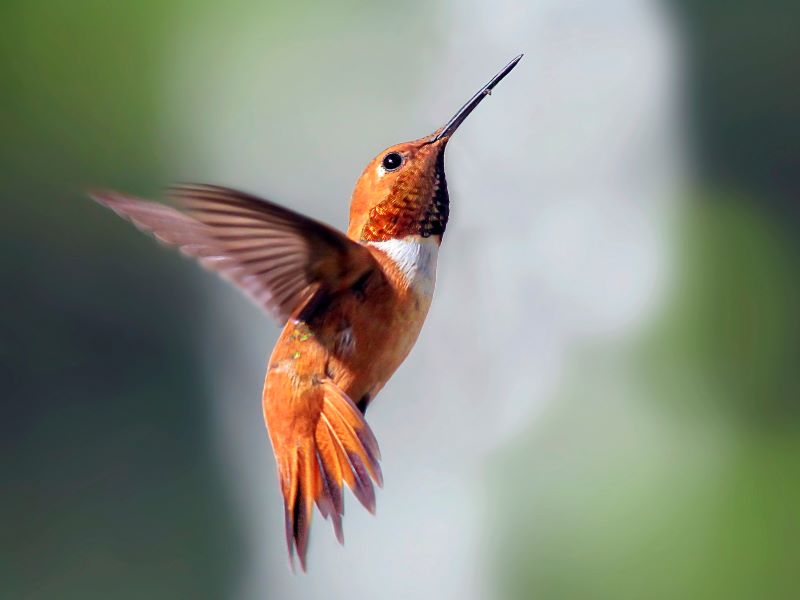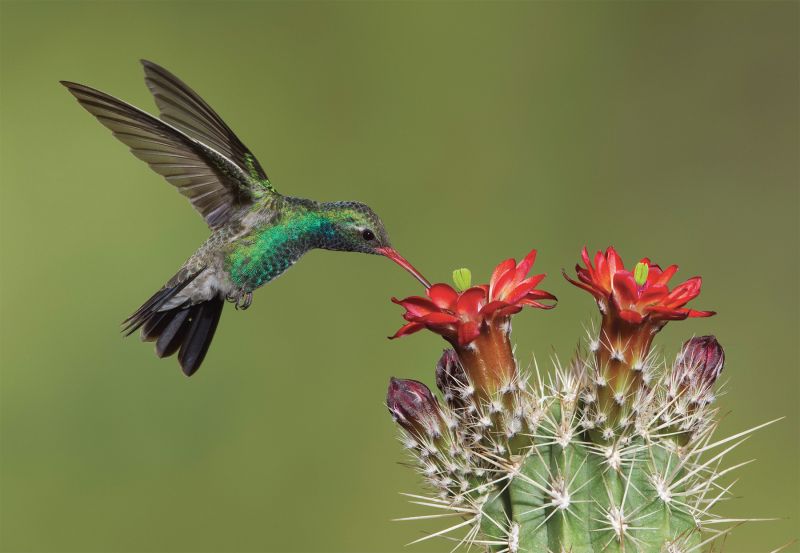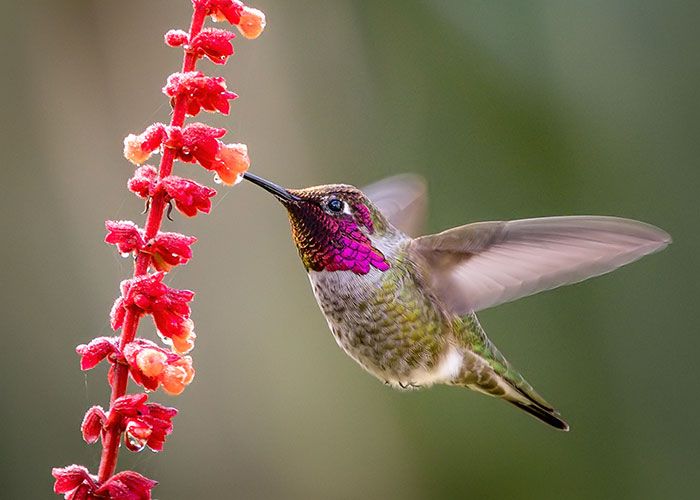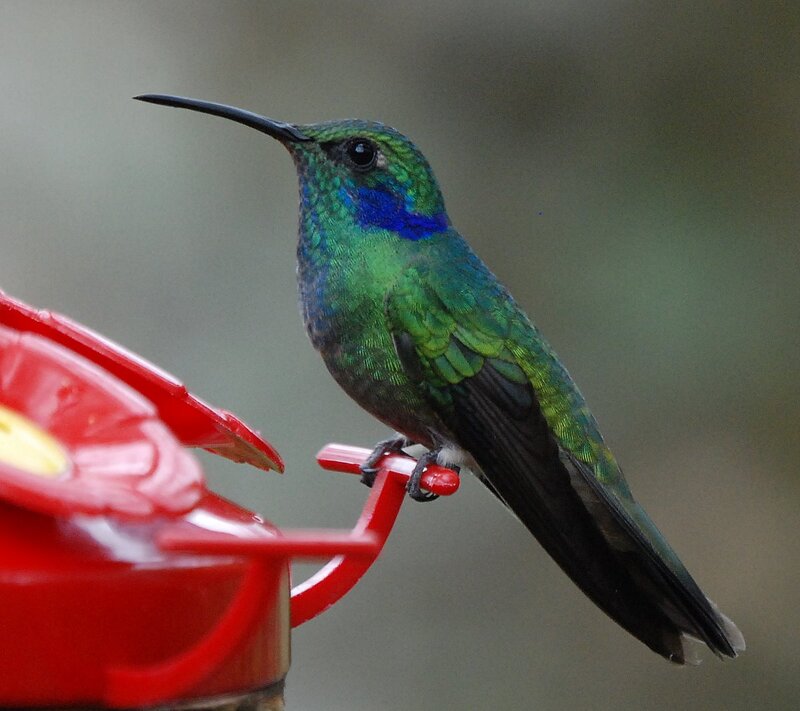Hummingbirds are mesmerizing little creatures. They appear out of nowhere, flitting from trumpet flower to trumpet flower with their feverishly beating wings. We could probably watch them for hours if only they wouldn’t disappear as quickly as they arrive. Lucky for you, we’ve got some photographs and images that might help you identify hummingbirds in Michigan. So pull up a chair, take a look out your window and see if you can spot one of the species we outline below.
There are over 330 species of hummingbirds, but chances are if you’ve seen one or more hummingbirds in Michigan, they’re probably of the ruby-throated variety. They are the only type commonly found in the Great Lakes State, although a handful of other varieties have been spotted on occasion. Here we’ll get to know each of them a little better.

Ruby-throated Hummingbird
Archilochus colubris
Why is it that male birds tend to be more colorful than their female counterparts? Scientists have found that females are attracted to more colorful males. Males also use their flash of color to demonstrate to other males that a certain territory belongs to them. There’s also a fair argument that females need to be duller in color to better camouflage themselves while nesting.
Whatever the reason, ruby-throated hummingbirds are no exception to this rule, as it is only the males that have those pretty iridescent red throats. You’re most likely to see these hummingbirds in Michigan during breeding season when they will often engage in dramatic diving flights of fancy upon seeing an attractive female. During this period, roughly May to August, they keep busy feeding and nurturing their young. Then in September, they make a beeline back to the tropics.
And what about that annual migration? Think how many times you’d stop to take a break while making a 500-mile road trip sitting down in a comfortable car. Then compare it to the ruby-throated hummingbird’s 500-mile excursion, completed twice a year. They make that trip non-stop. And they have to flap their wings the entire way. Did you know hummingbird’s wings beat between 50 and 200 times per second? And that they take 250 breaths per minute when at rest–and even more when flying? That’s pretty amazing if you ask me!
Ruby-throated hummingbirds weigh on average about 3 grams. To give you perspective, that’s about two-thirds the weight of a nickel! Males have a shimmery emerald or yellow-green back and head, grayish-white bellies, a red throat (of course!), and a long, pointed tail. As noted previously, females lack red throats. Theirs are white with light gray streaking. However, their bodies have the same iridescent green/gold coloring. And their tails are more rounded.
Like all hummingbirds, they have long, thin, needle-like bills which serve them well when extracting nectar from their favorite red or orange tubular flowers or from bird feeders. However, it is not their bill, but their long tongue inside that laps at the nectar.
When not in the tropics, ruby-throated hummingbirds prefer semi-open habitats, including gardens and wood edges. Nests are made in trees or tall shrubs. Females typically have one to two broods, laying two eggs per brood with an incubation period of 11 to 16 days. Hummingbird eggs are tiny, smaller than jellybeans.

Rufous Hummingbird
Selasphorus rufus
While they are more often found breeding in the Pacific Northwest and Alaska, Rufous hummingbirds have occasionally been sighted in Michigan, usually in the fall or winter. In the field, they are difficult to distinguish from Allen’s hummingbirds which sometimes results in a miscategorization.
Here again, it is the males that are the pretty ones with brilliant shades of rusty orange on their bodies and white chests. These pretty boys also have a patch on their throats, but instead of red, it is usually red-orange or yellow-green. Females tend to be of a dull green color on their backs and crowns with white, speckled throats.
Considering their tiny size, Rufous hummingbirds have surprisingly aggressive natures particularly when it comes to their staked out territories and their sources of food. In fact, it’s not uncommon to see them attacking other hummingbirds or much larger birds like jays, crows, and hawks if they think their food source is threatened. Like all hummingbirds, they are quite the sugar addicts needing to consume about half their weight in sugar each day, and so this may explain their aggressive behavior.
Like their red-throated cousins, Rufous hummingbirds tend to arrive in the United States around May for the breeding season. They depart once more for warmer climates around the end of September with males leaving first and females with their young following suit about two weeks later. And while you may have thought the 500-mile trip for Ruby-throated hummingbirds was long, that trip would be a piece of cake for Rufous hummingbirds. This species makes the longest migration of any other hummingbird, traveling 3,000 miles from Alaska and Canada to their winter homes in Mexico.

White-eared Hummingbird
Basilinna leucotis
A sighting of a white-eared hummingbird in Michigan was recorded in 2005. However, as far as hummingbirds in Michigan go, the likelihood of another occurrence would be rare. These birds are typically found much further south, making their homes in the high mountain forests of Mexico, and in New Mexico, and Texas.
Surprise! Surprise! It is the males once again that are the most colorful of the sexes. These birds are mostly green on their upper parts as well as the breast with blue-green throats and black and violet heads. Notably, males and females both sport white eyestripes that somewhat mimic an ear and which lends them their name, but even here, the male stripe is bolder.
During the breeding season, males are known to gather in loose groups to serenade prospective female partners. They’ll also participate in similar flight displays that other males use to attract mates.
Females will typically lay two eggs incubating them for 14 to 16 days. Once hatched they take care of feeding using their long bills to reach deep into the mouths of their young to deposit a mix of regurgitated insects and nectar. Yum!
Like most hummingbirds, white-eared hummingbirds often feed at red tubular flowers while hovering. Why red? Hummingbirds can see most colors, but they prefer bright reds and oranges because it is an indication the nectar inside is plentiful.
While we’re at it, here’s another fun fact about not only white-eared hummingbirds but virtually all hummingbirds. They can actually fly backward. In fact, they’re the only birds that can do this, and it’s because they have a ball and socket joint at their shoulders that allows 180-degree wing rotation.

Broad-billed Hummingbird
Cynanthus latirostris
It may be hard to believe, but the Broad-billed hummingbird eats 1-1/2 to 2-times its body weight in nectar daily. It forages for food in its native Mexico in canyons and foothills and along streambeds wherever there is an abundance of flowers.
They are also regular visitors to residential gardens and birdfeeders, the males easily recognized by their emerald green bodies, and deep blue throats, the females by their white eyestripe. This species of hummingbird has a black-tipped red bill. The tail is black and forked.
Like many hummingbirds, the male of the species aggressively defends its territory using strong intimidating flight tactics. The males will also use flight maneuvers to attract females.
Another interesting characteristic of Broad-billed and all other hummingbirds is how they sleep. Hummingbirds actually go into torpor, a near-hibernation state where they lower their body temperature, their heartbeat, and respiration rate to about 1/15th of what they normally require. This slowing of their metabolism allows them to conserve energy so they will require less food. During their torpor, they will typically hang upside down from a tree branch.

Anna’s Hummingbird
Calypte anna
A mid-sized hummingbird with a large head, Anna’s hummingbirds are typically found year-round along the Pacific coast. They feature bronzed-greenish backs and grey chests. Their bills are long and straight. Males, as you no doubt have guessed, are the showier of the sexes with iridescent rosy pink throats that continue on up to their crown.
Anna’s hummingbirds are unique in that the males put on a vocal display during courtship. Described as “raspy.” (I’m thinking Rod Stewart, but that may be a stretch.) These vocalizations increase in intensity and are followed by physical displays including dive bombs from as high as 130 feet where the male will use its tail feathers to make loud and sudden explosive popping sounds.
These birds forage in a variety of habitats including gardens, open woods, along streambeds, and in coastal sage scrub.
Annas hummingbirds are one of many hummingbird species, including Allen’s, Costa’s, Black-chinned, Calliope, Rufous, and Broad-tailed hummingbirds, that will breed together forming a variety of hybrid species. This practice can make it extremely difficult to identify them.

Mexican Violetear
Colibri thalassinus
No list of hummingbirds in Michigan would be complete without the Mexican violetear. Previously known as the Green violetear, it is named for its brilliant green and blue plumage, bronze-like central feathers, and violet patches on the sides of its head. This bird also has a violet central spot on the upper portion of its chest. It has a slightly notched, square-shaped tail with a blue bar of color near the end of the tail. Nomadic by nature, the Mexican violetear can be found in the mountains of southern Mexico, Honduras, and Costa Rica but is known as a vagrant, wandering far, and at times as far as Michigan!
Mexican violetears weigh in at about 4.8 to 5.6 grams, so unlike the ruby-throated variety, this species is actually heavier than a nickel! Like most hummingbirds, they feed on a steady diet of nectar and insects, foraging in subtropical and lower temperate forests, scrub and woodland, and wherever flowers are plentiful. Their range is substantial, estimated at about 800,000 square kilometers, and their population is believed to be plentiful also.
Females typically lay two eggs, which they incubate for 14 to 18 days. They can live to 12 years in the wild.
If Only There Were More Hummingbirds in Michigan!
Have you ever stopped to wonder why a group of crows is called a murder and a group of grackles a plague, but hummingbirds are often referred to as a bouquet, a shimmer, a charm, or a tune?
Tiny, beautiful, and wonder of nature, it seems entirely unfair that so many hummingbird species choose to stay in the tropics year-round. But that’s the way it is sometimes. This summer, when they come to Michigan, be sure to enjoy them while you can!
Related
- Want to see more hummingbirds in your yard? We’ve got you. Check out our article on turning your backyard into a sanctuary for hummingbirds.
- Ever wondered why hummingbirds chase each other? It turns out there are some primal reasons at play. Check out our article on it: Why Do Hummingbirds Chase Each Other?
I live in a forest in SW Michigan and I have Black Chinned Hummingbirds.
Just had one at our feeder in NW Michigan!